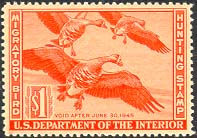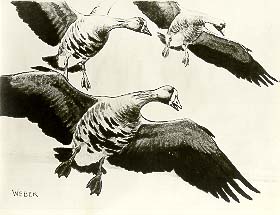

Back to RW11 Back to the Federal Index Home
A LITTLE HISTORY ON THE 11TH (1944-45) DUCK STAMP ARTIST


Walter A. Weber was raised in the "Windy City" and stayed there for most of his early life. He was born in Chicago on May 23, 1906, the son of Jacob and Antoinette Kreml Weber. There he received all of his formal education and there he worked for several years after he graduated from college.
As a child, he had a varied and very active collection of whatever living things he could catch and keep. Beetles, squirrels, crows, ants, mice, raccoons, and turtles all frolicked through his collection at one time or another. He also liked to gather plants from their natural habitat to use as subjects for his soda pop sketches. It was this insatiable curiosity about plant and animal life that later influenced both his studies and his art.
He was led by his interests to study zoology and botany at the University of Chicago, where he graduated in 1927 wit a B.S. degree as a Phi Beta Kappa. He received his art education at the Chicago Art Institute, the American Academy of Art, and the Church School of Art.
Although he was only 22 years old, Mr. Weber was now trained well enough as a scientific illustrator that he was able, in 1928, to join the staff of the Chicago Field Museum (presently The Chicago Museum of Natural History). He traveled extensively for the museum visiting every continent except Antarctica. He was artist and ornithologist for the Crane Expedition to the South Pacific in 1928-29. In the winter of the next year, he made an expedition to Bermuda to paint fish for Mr. Cornelius Crane. He went, in the summer of 1936, to British Columbia to study under Major Allan Brooks, the well-known bird artist, who did many series for the National Geographic magazine. This was invaluable experience for Mr. Weber, a man who was rapidly developing his own style. The two men spent four months together, working much of the time in the field.
For the next two years, Mr. Weber served as a biologist and artist for the Century of Progress Exposition in his home town. After that, he tried his skills as a free-lance artist for two years. He specialized mainly in advertising art and commercial illustration.
Mr. Weber continued his museum work, organizing and painting backgrounds for the biological exhibits at the Texas State Memorial Museum in 1936. After that work was done, he went to Washington D.C. and worked as a wildlife technician with the National Park Service. He transferred to the staff of the U.S. National Museum five years later and, in 1942, was sent as an ornithologist to southern Mexico (Tabasco and Vera Cruz) on a Smithsonian Institution--National Geographic Society expedition.
In March of the next year, Mr. Weber returned to free-lance art and late in that year did the watercolor painting tat was selected for use on the 1944-45 Duck Stamp.
Mr. Weber died in January 1979 while living in Lynchburg, Virginia.
-------------------------THE ART-------------------------
White-fronted Geese was done in watercolor wash. A stone lithograph was prepared
and prints were hand pulled on white Rives paper using brown and black ink. The
prints were signed in both ink and pencil but not numbered. The print image
size is 6 1/2" x 9 1/2"
-------------------------THE STAMP-------------------------
White-fronted Geese...Engraved by the Federal Bureau of Engraving from the original
artwork. Printed in red-orange ink. The stamp sold for one dollar.
Postal records show 1,487,029 stamps sold. First day of sale was July 1, 1944.
Most of the information contained above is from the book Federal Duck Stamp Story, Fifty Years of Excellence, by Laurence F. Jonson; Alexander & Co. It is used here with permission from the author. For more information on this book, please click here.